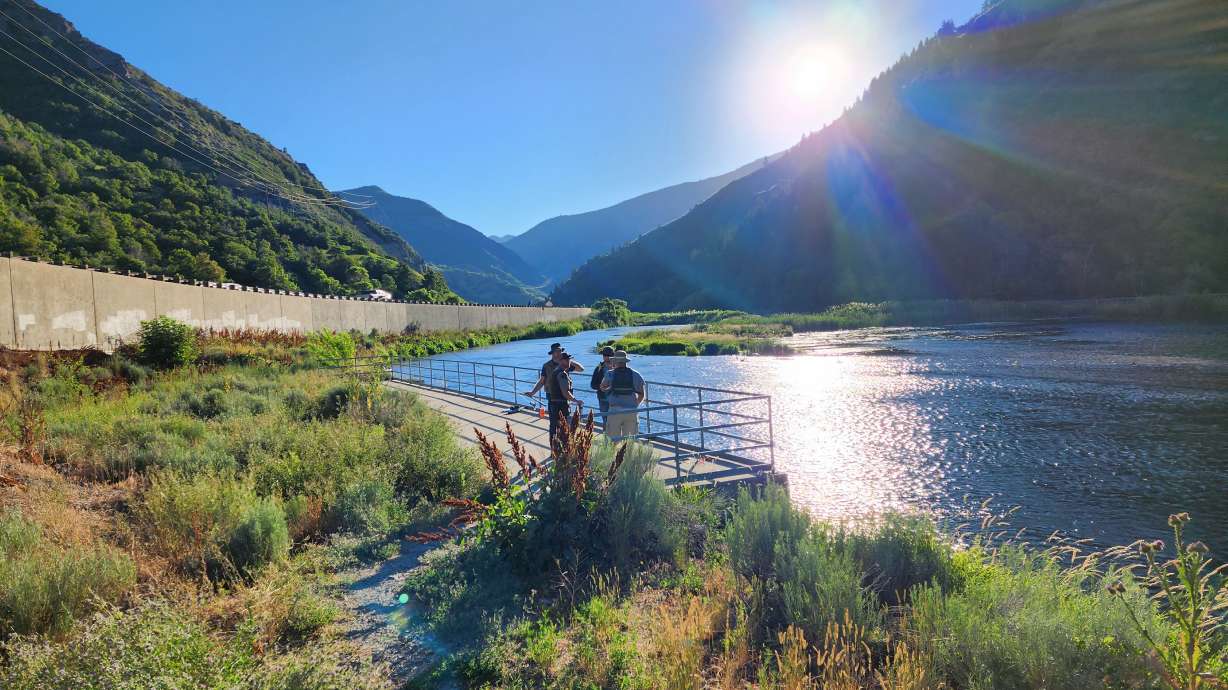Estimated read time: 5-6 minutes
This archived news story is available only for your personal, non-commercial use. Information in the story may be outdated or superseded by additional information. Reading or replaying the story in its archived form does not constitute a republication of the story.
PROVO — Utah Division of Wildlife Resources conservation officer Devin Shirley was recently called to assist a U.S. Forest Service law enforcement officer at a remote campsite on federal lands above Diamond Fork Canyon, in Utah County. It was trashed and it seemed the campers had exceeded the legal time limit for their stay.
One federal Forest Service officer covers a large area extending roughly from Mt. Nebo to Diamond Fork Canyon in Juab, Utah and Wasatch counties. Shirley, who's been a conservation officer for nearly five years, is used to being alone and beyond cell coverage while patrolling land in two of those counties.
The adult campers had allegedly been using illegal narcotics with children present. According to Shirley, child protective services arrived in 45 minutes. A Utah County Sheriff's Office deputy also responded and arrested the adults present.

Significant amounts of narcotics were found at the campsite. Between the three cooperating agencies, those arrested face federal, state and county charges.
"My job is to enforce the fishing, hunting and trapping laws of the state of Utah in my district, but I have statewide law enforcement jurisdiction, so I patrol a given area and also go where the problems are," Shirley, who most often refers to himself as a game warden, said.
That can include being on call near his home. And, yes, a conservation officer can also pull you over for excessive speed or impaired driving.
In addition to daily law enforcement duties, including having a presence in those remote campgrounds, the Division of Wildlife investigates poaching in Utah.
"Depending on how broadly you want to define poaching, it can include not understanding the restrictions on hunting, fishing and trapping," Shirley said. "Any time an animal is taken without proper licensing, or adhering to limits, it is stealing from the people of Utah."
Studies show just 2% to 3% of big game poachers are caught and prosecuted in America. The Utah Division of Wildlife Resources relies heavily on tips from the public toward that end.

The state's Division of Wildlife Resources requires officers to have either six years prior law enforcement experience or a college degree; Shirley has a master's degree.
One fairly recent Saturday, Shirley left a DWR office in Springville early in the morning to head to Provo Canyon, where anglers were already gathered on the lower Provo River.
The state has designated blue ribbon fisheries, and the area of the river between Deer Creek Dam and Olmstead Diversion Dam is one of them. On the way up the canyon, Shirley stopped several times to check fishing licenses and ensure anglers were adhering to catch limits and size restrictions on the river.
At one point Shirley had to switch from a Salt Lake City-based dispatch system to one located in Wasatch County. Radio and cell coverage is often spotty where he patrols. He and other game wardens, as well as sheriff's deputies and UHP troopers, keep in touch with one another in rural areas and assist each other as needed.
After checking on staffing at a Utah port of entry where mandatory boat inspections were taking place, Shirley proceeded southeast on state Route 40 toward Strawberry Reservoir. At nearly 7,600 feet elevation, Strawberry's cold waters make it more of a fishing destination than one for recreational boating.
Shirley met up at the reservoir with conservation officer McKay Braley, who brought the boat to conduct boat safety inspections, fishing-license checks, and slot limit restrictions for cutthroat trout. Anglers can't keep cutthroat between 15 and 22 inches, as they are prime breeding size and prey upon invasive species in the lake.

Braley spends much of his time patrolling Strawberry Reservoir; snow machines are used to patrol the frozen lake in winter.
Game wardens also watch for potentially impaired boat drivers — Braley estimates three or four DUI arrests each year at Strawberry, a number that would be higher if recreational boating were more prevalent at the lake.
The boat is unmarked, and fishing poles and tackle were aboard. The officers fish and try to blend in, while one is always monitoring the shoreline and other boats, through binoculars, for possible fishing violations. Before heading to the boat ramp, Shirley and Braley changed out of their uniform shirts and bulletproof vests in favor of plaid shirts similar to what many other anglers would be wearing.
Before leaving the marina, Braley flashed his badge and cautioned one boat that, under Utah law, any children under the age of 13 must be always wearing a life jacket while on the water. Braley has investigated more than one drowning of a child at Strawberry and he is determined to not have to investigate another.
Among the many fishing violations, citations were given for faulty boat horns and expired fire extinguishers. The wardens keep a cooler in the boat to confiscate illegally caught fish. They often give them to families in need, Braley said.
After a few hours on the boat, Shirley drove to a parking area on the lake's eastern-most shore. From there he walked the shoreline, checking fishing licenses and making sure fishing limits were being respected.
In one case, a kayaker was cited for having an unregistered boat. His trawling motor, used for fishing, made the kayak a motorized vehicle subject to registration with the state — same as any other motorized boat or vehicle.
Shirley took the long way down the canyons, following a maze of dirt roads that traversed Wasatch and Utah counties by way of U.S. Forest Service land and campgrounds. He eventually met up with pavement at the top of Diamond Fork Canyon and proceeded down Spanish Fork Canyon, back to Springville.








